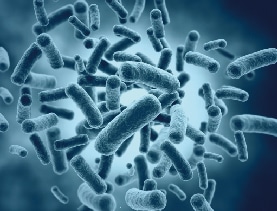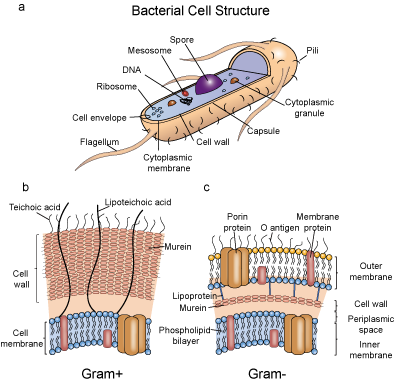Bacterial Antigens
Bacterial Background
The Morphology and Fine Structure of Bacteria

Related Resources
Infection Immunity
Infectious Disease ELISA kit
Bacterial cells are between 0.3 and 5 lm in size. They have three basic forms: cocci, straight rods, and curved or spiral rods (Table 1). The nucleoid consists of a very thin, long, circular DNA molecular double strand that is not surrounded by a membrane. Among the nonessential genetic structures are the plasmids. The cytoplasmic membrane harbors numerous proteins such as permeases, cell wall synthesis enzymes, sensor proteins, secretion system proteins, and, in aerobic bacteria, respiratory chain enzymes. The membrane is surrounded by the cell wall, the most important element of which is the supporting murein skeleton (Figure 1a). The cell wall of Gram-negative bacteria features a porous outer membrane into the outer surface of which the lipopolysaccharide responsible for the pathogenesis of Gram-negative infections is integrated (Figure 1c.). The cell wall of Gram-positive bacteria does not possess such an outer membrane. Its murein layer is thicker and contains teichoic acids and wall-associated proteins that contribute to the pathogenic process in Gram-positive infections (Figure 1b.). Many bacteria have capsules made of polysaccharides that protect them from phagocytosis. Attachment pili or fimbriae facilitate adhesion to host cells. Motile bacteria possess flagella. Foreign body infections are caused by bacteria that form a biofilm on inert surfaces. Some bacteria produce spores, dormant forms that are highly resistant to chemical and physical noxae.
 Figure 1. Bacterial cell structure (a), cell wall structure of Gram+ (b) and Gram- (c) bacterial.
Figure 1. Bacterial cell structure (a), cell wall structure of Gram+ (b) and Gram- (c) bacterial.
Table 1. Morphological Characteristics of Bacteria.
| Bacterial form | Remarks |
|---|---|
|
|
The pathogenesis of bacterial infection includes initiation of the infectious process and the mechanisms that lead to the development of signs and symptoms of disease. The biochemical, structural, and genetic factors play important roles in bacterial pathogenesis. Characteristics of bacteria that are pathogens include transmissibility, adherence to host cells, persistence, invasion of host cells and tissues, toxigenicity, and the ability to evade or survive the host's immune system. Resistance to antimicrobials and disinfectants can also contribute to virulence, or an organism's capacity to cause disease. Many infections caused by bacteria that are commonly considered to be pathogens are inapparent or asymptomatic. Disease occurs if the bacteria or immunologic reactions to their presence cause sufficient harm to the person.
Bacterial Birulence Factors
Virulent bacteria cause disease through the elaboration of factors that facilitate adherence, persistence, invasion, and toxigenicity. Genes that encode virulence factors may be carried on mobile genetic elements such as plasmids or bacteriophages or are found on large pathogenicity islands on bacterial chromosomes.
- Pili and fimbriae are rod-like or hair-like structures, respectively, that facilitate attachment to host cells. When bacteria enter the body of the host, they must adhere to cells of a tissue surface. If they did not adhere, they would be swept away by mucus and other fluids that bathe the tissue surface. Bacteria also have specific surface molecules that interact with host cells. Many bacteria have pili, thick rod-like appendages or fimbriae, shorter “hair-like” structures that extend from the bacterial cell surface and help mediate adherence of the bacteria to host cell surfaces.
- Invasion of host cells is a complex mechanism that involves elaboration of proteins that facilitate entry. For many disease-causing bacteria, invasion of the host's epithelium is central to the infectious process. Some bacteria (eg, Salmonella species) invade tissues through the junctions between epithelial cells. Other bacteria (eg, Yersinia species, N gonorrhoeae, Chlamydia trachomatis) invade specific types of the host's epithelial cells and may subsequently enter the tissue. When inside the host cell, bacteria may remain enclosed in a vacuole composed of the host cell membrane, or the vacuole membrane may be dissolved and bacteria may be dispersed in the cytoplasm. Some bacteria (eg, Shigella species) multiply within host cells, but other bacteria do not.
- Bacterial toxins may be extracellular (exotoxins) or are a component of the bacterial cell membrane (endotoxin, LPS) and are among the most powerful toxins in nature (eg, botulinum toxin). Many gram-positive and gram-negative bacteria produce exotoxins of considerable medical importance. Many exotoxins consist of A and B subunits. The B subunit generally mediates adherence of the toxin complex to a host cell and aids entrance of the exotoxin into the host cell. The A subunit provides the toxic activity. The LPS (endotoxin) of gram-negative bacteria are bacterial cell wall components that are often liberated when the bacteria lyse. LPS in the bloodstream is initially bound to circulating proteins, which then interact with receptors on macrophages neutrophils and other cells of the reticuloendothelial system. Proinflammatory cytokines such as IL-1, IL-6, IL-8, TNF-α, and other cytokines are released, and the complement and coagulation cascades are activated. The following can be observed clinically or experimentally: fever, leukopenia, and hypoglycemia; hypotension and shock resulting in impaired perfusion of essential organs (eg, brain, heart, and kidney); intravascular coagulation; and death from massive organ dysfunction.
- Other mechanisms important to bacterial survival and virulence include tissue-degrading enzymes, anti-phagocytic factors, IgA proteases, antigenic heterogeneity, and the ability to chelate iron.
- There are at least seven known bacterial secretion systems, protein complexes, or channels that ensure transport of structural and toxigenic proteins through the bacterial cell after translation.
Hot Products